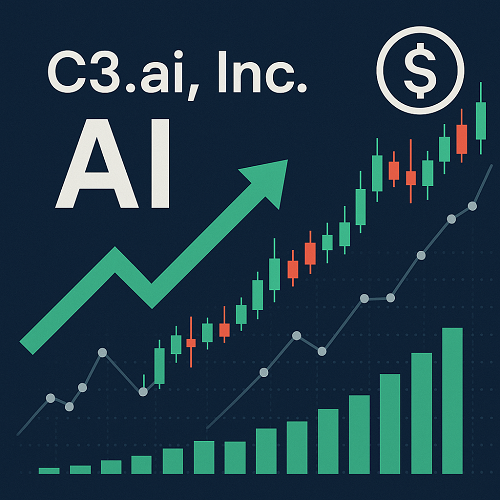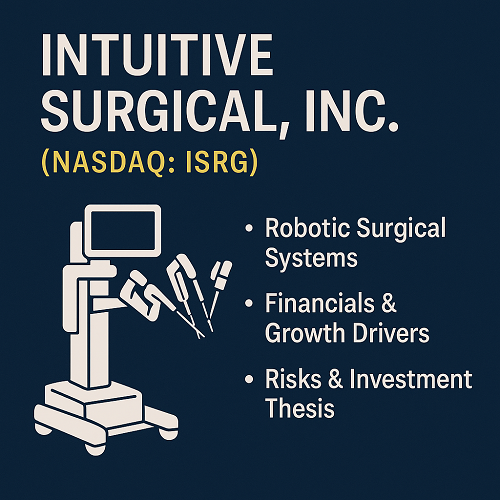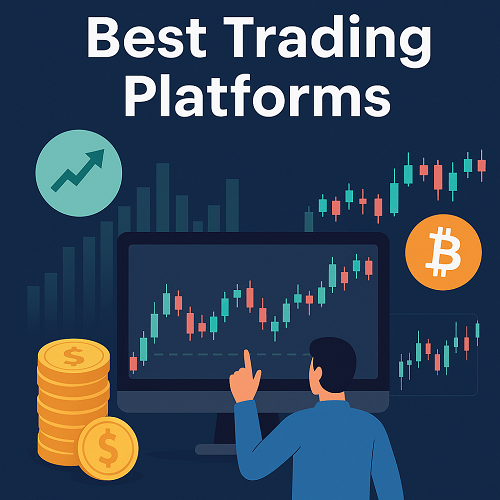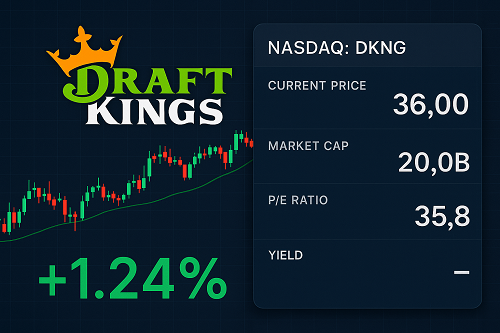Why C3.ai Matters in the AI Revolution
In today’s technology landscape, artificial intelligence isn’t just a buzzword — it is rapidly transforming how enterprises operate, automate and extract value from data. Amid this shift stands C3.ai, Inc. (NYSE: AI) — a company that has positioned itself as a pure-play in the enterprise AI applications space.
For investors and traders alike, C3.ai presents a high-risk, high-reward opportunity: if the company can execute, scale and sustain growth, the upside is compelling. But if execution falters or competition intensifies, the downside could be steep.
This article will walk through why C3.ai matters, how it makes money, its market context, financials, valuation, key risks, and how one might think about trading or investing in the stock — all structured for clarity, depth and search performance.
By the end, you should have a clear picture of:
- What makes C3.ai unique (and what doesn’t)
- The realistic financial and valuation landscape
- Key catalysts, risks and how to position for them
- Practical strategies for both mid-/long-term and shorter-term trading/investing
Key search/SEO phrases covered: “C3.ai stock analysis 2025”, “enterprise AI software investment”, “how to trade C3.ai”, “C3.ai valuation metrics”, “C3.ai risks and opportunities”.
Company Overview: History, Business Model & Positioning
Founding & evolution
C3.ai was founded in 2009 by tech entrepreneur Thomas Siebel (originally as C3 Energy) and later pivoted into enterprise AI and analytics.
The company went public in 2020 on the NYSE under ticker “AI”. The business is headquartered in Redwood City, California.
Business model
C3.ai’s core value proposition is: enable large enterprises to build, deploy and operate AI-driven applications at scale — combining data ingestion, machine learning, operationalization, monitoring and domain-specific solutions.
Key elements of its model:
- Subscription revenue: Recurring SaaS-type revenue from customers licensing the C3.ai Suite. For example, Q4 FY2025 subscription revenue was ~$87.3 m, up from ~$79.9 m the prior year.
- Professional services / support: Implementation help, customizing, consulting. These can be volatile and lower margin.
- Large enterprise clients: Many clients are large-scale (10,000+ employees) and industrial, which leads to higher potential contract value but longer sales cycles and higher execution risk.
Market positioning & differentiators
What sets C3.ai apart:
- A dedicated enterprise AI platform (rather than generic analytics) focused on operational AI and IoT/industrial use-cases.
- Strategic alliances with major cloud providers and system integrators (e.g., Microsoft’s Azure, AWS, Google Cloud) which help distribution, credibility and scale.
- Domain‐specific “accelerators” or packaged solutions (for manufacturing, utilities, oil & gas etc.) which may shorten deployment time-to-value.
- Early-mover in enterprise AI applications in certain sectors (though that advantage may erode).
But the positioning also has caveats:
- The market is becoming crowded: many large software vendors, cloud companies and niche AI firms are targeting overlapping spaces.
- Differentiation must be meaningful and maintained — if platform becomes a commodity, pricing and margins could shrink.
- Customer concentration and long sales cycles increase risk.
Key Products, Technologies & Competitive Advantages
The C3.ai Suite
The stack includes capabilities to:
- Ingest large volumes of structured and unstructured data (including from IoT sensors, enterprise systems, logs)
- Apply machine learning, deep learning and other AI models
- Develop and deploy AI applications (for example predictive maintenance, anomaly detection, supply-chain optimization)
- Monitor and operate those applications in production (model drift, performance tracking, scalability)
These capabilities are more complex than a simple analytics dashboard. They target operational AI at scale.
Industry Accelerators & Use-Cases
C3.ai offers domain-specific starting points — for example utilities, oil & gas, manufacturing, energy, financial services. These accelerators help reduce time to deployment and make the platform more “enterprise-ready”. The company has highlighted renewals/expansions (e.g., with Baker Hughes) as evidence of traction.
Partner Ecosystem
Partnerships with major cloud providers and global systems integrators are critical to scale: they help with distribution, infrastructure, adoption, and credibility. For example, C3.ai emphasizes being a “preferred AI application provider” on Azure.
Competitive strengths & moat potential
- Scale potential and large deals: If C3.ai successfully lands and scales large enterprise engagements, the switching cost and value creation could create a moat.
- Vertical specialization: By focusing on industrial/operations rather than just horizontal AI tools, they may differentiate.
- Recurring revenue model: Subscription revenue implies ongoing value and potentially higher margins once scale is achieved.
Key weaknesses/challenges
- High execution complexity: Deploying operational AI at scale in large enterprises is hard — data silos, legacy systems, culture change.
- Customer concentration & long sales cycles: If a few clients dominate revenue, losing one can be material.
- Competitive threats: Large incumbents (Microsoft, Oracle, SAP), cloud providers, specialized AI firms and open-source alternatives may erode pricing or gain share. For example, C3.ai’s market share in certain segments is quite small.
- Margin pressure: Professional services weigh on margins; if growth slows, profitability could suffer.
Market & Industry Context: Tailwinds, TAM, Competitors
Market size & growth drivers
The enterprise AI software market is expanding rapidly, driven by:
- The increasing volume of data and IoT sensor-driven operations.
- Growing demand for predictive analytics, optimization, automation of business/industrial workflows.
- Shift from AI pilots/proofs-of-concept to full production deployments.
- The move to cloud/SaaS models which lowers barrier to adoption and offers scale.
- Regulatory and operational pressures (sustainability, supply-chain resilience, energy efficiency) that push enterprises toward AI solutions.
While precise TAM numbers vary, analysts view the space as multi-tens of billions of dollars (and growing). C3.ai claims to operate in that high-growth zone.
Competitive landscape
Key competitors and overlapping categories include:
- Traditional enterprise software vendors embedding AI/analytics (e.g., Microsoft Corporation, SAP SE, Oracle Corporation).
- Cloud-native AI/ML platforms from AWS, Azure, Google Cloud — they may compete or complement enterprise AI application vendors.
- Specialized AI software firms and start-ups focusing on vertical applications or point solutions (e.g., DataRobot).
- Open-source frameworks and internal enterprise builds which can reduce need for third-party solutions.
C3.ai’s market share is very small in many segments. For example, one analysis showed its share in the threat-detection and prevention category at ~0.32%.
Tailwinds vs headwinds
Tailwinds:
- Enterprises shifting from pilot to deployment in AI and operationalizing AI.
- Increase in industrial IoT and need for predictive/optimization models.
- Expansion of cloud infrastructure and willingness to adopt SaaS AI.
- Partner ecosystem enabling global reach and deployment scale.
Headwinds:
- Customer budget constraints (especially in macro downturns).
- Competitive pressure and commoditization of AI capabilities (making pricing less generous).
- A slowdown in enterprise software spending could impact growth.
- Execution risk remains high (deployment complexities).
- Valuation risk: many AI software stocks are richly priced, so growth must meet high expectations. Indeed, one central bank warned of an “AI stock bubble”.
Financial Performance & Metrics
FY2025 Highlights
According to the company’s release:
- Full-year revenue ended April 30 2025 was $389.1 million, up +25 % versus prior year.
- Q4 FY2025 revenue was $108.7 million (up 26% YoY).
- Subscription revenue in Q4 grew ~9% (to ~$87.3 m) compared to ~$79.9 m year-ago.
- The company remains unprofitable: net loss ~US$288.7 million in FY2025.
Key metrics to monitor
- Revenue growth: ~25% in FY2025 is solid, but growth must accelerate for high valuation.
- Margin trends: Operating margin, gross margin, subscription vs services mix.
- Recurring revenue / subscription ratio: Services revenue is more volatile. Move toward higher subscription mix can improve predictability.
- Cash flow & cash runway: Important to know how long the company can operate with current burn.
- Customer concentration & contract size: Few large deals may dominate results — risk if one is delayed or lost.
- Valuation relative to peers: Growth expectations baked in matter.
What the numbers say
- A 25% growth rate is respectable in enterprise software, but not spectacular in the “AI hype” era (where many expect 30-50%+ growth).
- Subscription growth of only ~9% in Q4 is less impressive, indicating a drag from slower services or large client dynamics.
- The large net loss and high burn mean the company must scale and move toward profitability for valuation justification.
- Given competitive pressure and macro risk (enterprise spend), there is some risk of growth deceleration.
Interpretation for investors/traders
- The story is intact: enterprise AI is a compelling opportunity; C3.ai is among the small set of players focused purely on this.
- But the execution must improve: higher subscription growth, margin expansion, and visibility into future contracts.
- The valuation discount may exist given risk — this can offer a trade setup for those who believe in the turn-around or acceleration.
- On the flip side, if growth slows or margins worsen, multiple re-rating down is not unlikely.
Valuation frameworks
- EV/Revenue: Given the company is unprofitable, the EV/Revenue multiple is more relevant than P/E.
- PEG (Price/Earnings-to-Growth): While earnings are negative now, if one projects future earnings one could compute a PEG once positive earnings are expected.
- Growth premium: Many investors are willing to pay higher multiples for companies with strong growth and market leadership. But that premium comes with risk.
- Relative valuation: Compare C3.ai to other enterprise software companies or AI-software vendors (growth, margin profile, risk).
Example valuation scenario
- If revenue grows from $389 m this year to, say, $600 m in 2-3 years (which implies ~25–30% CAGR) and profitability begins, one could argue a multiple of, say, 5–8x revenue or more if everything goes well.
- Conversely, if growth stagnates at ~15–20%, margin expansion slow, the multiple may contract.
- Given current price and revenue, the risk/reward depends heavily on future growth acceleration and margin improvement.
Risk-adjusted view
- Upside case: Growth accelerates to 30–40%, enterprise deployments scale, margins improve, the market re-rates the company to higher multiple → significant upside.
- Base case: Growth remains ~20–25%, margins improve gradually, valuation remains steady → moderate upside.
- Downside case: Growth slows <15%, margins deteriorate, competition bites → multiple compresses, downside risk emerges.
Investment/trading signals
- Monitor new large contracts, renewals, subscription growth, churn, professional services percentage.
- Pay attention to guidance: If C3.ai issues weak forward guidance or churn increases, the stock may react sharply.
- For traders: volatility around earnings, partner announcements, contract wins/losses can present setups.
- For long-term investors: ask if current valuation makes sense given best-case growth, and whether you’re comfortable with execution risk.
Risks & Headwinds
Understanding risk is critical — for a high-growth company like C3.ai, both upside and downside are elevated.
Key risks
- Execution risk: Large enterprises have long sales cycles; converting pilots to production deployments is challenging. Delays can affect revenue growth and investor sentiment.
- Competitive risk: Intensifying competition from large incumbents, cloud providers, and niche AI firms could erode pricing and market share.
- Customer concentration: If a small number of customers contribute a large portion of revenue, losing or delaying one contract could sway results materially.
- Macro / budget risk: In economic downturns, enterprise IT/AI spending can be cut; this may hurt growth prospects.
- Valuation risk: With high expectations baked in, any disappointment in growth or margin can lead to sharp multiple contraction. Also, central banks and analysts are warning of AI-stock bubbles.
- Technology & product risk: If C3.ai fails to keep pace with the AI innovation curve, or fails to maintain differentiation, its value proposition could diminish.
- Leadership & governance risk: Transition in leadership, issues in strategy or execution may add uncertainty.
What to watch for
- Changes in subscription growth rate (especially meaningful for SaaS model).
- Any shift in services share (higher services share may indicate less scalable business).
- Renewal rates, churn, average contract size trends.
- Guidance updates from company and analyst revisions.
- Competitive announcements or large customer wins by competitors.
- Macro/industry indicators of enterprise software spend.
- Leadership changes or strategic pivots.
How to Trade or Invest in C3.ai
Long-term investing approach
For those looking at 3-5 year horizons:
- Evaluate thesis: Do you believe enterprise AI will scale significantly, and that C3.ai is a winner?
- Check fundamentals: Growth rate, subscription mix, margin trajectory, cash run-way.
- Valuation discipline: Make sure you’re comfortable with valuation relative to growth/profit expectations.
- Diversify: High risk means you may want to limit exposure.
- Set milestones & review regularly: For example: “By end of FY2026, subscription revenue should grow >20%.”
- Risk management: Understand your downside and use stop-loss or adjust position size accordingly.
Short-term/trading approach
For shorter (months to 1-year) horizons in the stock:
- Focus on catalysts: earnings releases, contract announcements, major partner deals, industry news.
- Use technical levels: support/resistance, trendlines, average volumes.
- Be nimble: because this stock can swing with sentiment, macro cues (interest rates, tech sector movements) matter.
- Risk control: Set stop loss, protect against gap downs, avoid overleverage.
- Monitor sector sentiment: AI stocks as a group can move together; a shift in sentiment can amplify moves.
Strategy examples
- Catalyst play: Buy ahead of major contract announcement, short-term hold until market reacts.
- Turnaround play: Buy if you believe management will accelerate growth and re-rate the stock — longer hold.
- Hedge/trading: If you hold the stock long-term, consider protective puts or stop-losses given volatility.
- Avoid/underweight: If you’re risk-averse and doubt execution, you may prefer to sit out or short (if you believe downside is likely).
Key trading/investing checklist
- Does the company show improvement in subscription growth and recurring revenue?
- Are large enterprise deals growing in number and size?
- Are margins improving (gross margin, subscription margin, operating margin)?
- Is guidance on target and conservative or optimistic?
- What is the competitive landscape doing? Are new entrants or incumbents gaining share?
- Are macro/industry conditions supportive of enterprise software spend?
- Is the valuation justifiable given these assumptions?
- Are you comfortable with the risk if things go awry?
Outlook & Scenarios for C3.ai
Here are three scenario frameworks (3-5 year horizon) to frame thinking.
Bull Case
- C3.ai successfully transitions multiple large enterprises from pilot to full production deployments, ARR ramps significantly.
- Subscription growth accelerates from ~25% to 35–40%+ annual growth.
- Gross margins and operating margins improve meaningfully as scale kicks in.
- Major partnerships yield global scale, international expansion takes off.
- Market re-rates the company to a high multiple (e.g., 8x revenue or higher) given sustained high-growth profile.
- Stock significantly appreciates (2x–3x+ from current levels) as confidence returns and execution meets expectations.
Base Case
- Growth remains in the ~20-25% range annually, subscription mix gradually improves, but no dramatic acceleration.
- Margins improve modestly; profitability still a few years away.
- Valuation remains stable or moderately improves.
- Stock delivers moderate upside (e.g., 30-80% over 3-5 years) but with continued volatility.
- Execution meets expectations but does not blow them away.
Bear Case
- Growth decelerates toward ~10-15% due to competitive pressure, budget cuts, or sales execution issues.
- Subscription growth stalls or services mix increases (reducing scalability).
- Margins do not improve or even worsen.
- Valuation compresses as market becomes skeptical of the enterprise AI growth story.
- Stock may underperform or decline materially (potential loss of 30%+ or more over several years).
Key external/catalyst factors
- Macro: A downturn in enterprise IT spending would hurt.
- AI hype cycle: If sentiment turns cold, high-growth AI stocks may be punished.
- Contract wins/losses: Large deal announcements or cancellations can swing trajectory.
- Innovation: Success in new product launches (agentic AI, generative AI applications) could accelerate adoption.
- Competitive moves: If a major competitor wins large market share, C3.ai’s growth could be impacted.
Conclusion & Key Take-aways
C3.ai offers a compelling exposure to the enterprise AI wave — a sector of high interest, high growth potential, but also high risk. If you believe that industrial/enterprise AI deployments are ramping in a meaningful way, and that C3.ai has the right platform, partners and execution, then this stock could be a strong growth investment.
However, the story is far from locked in. Growth must accelerate, margins must improve, competition must be managed, and execution risks overcome. The current valuation reflects high expectations — meaning there is less room for error.
Key take-aways:
- The enterprise AI software opportunity is large and growing, but many companies will compete and execution will vary.
- C3.ai shows decent growth (~25% in FY2025) but still has work to do in terms of subscription growth and scaling.
- Valuation is tied heavily to future growth and margin improvement — monitor milestones.
- Risk is real: execution, competition, macro, and high expectations.
- For traders and investors: position sizing and risk management are critical.
- Three horizon scenarios (bull/base/bear) clarify how outcomes could diverge and what to watch.
Final thought
If you’re bullish on enterprise AI and believe C3.ai will emerge as a leader, then under current pricing the stock may represent an attractive risk/reward. If you’re cautious, the company may still need to prove itself further — waiting for clearer signs of scaling and profitability may be prudent.
FAQ
Q: When will C3.ai become profitable?
A: The company is not yet profitable. It will depend on how fast subscription growth ramps, services mix improves, and cost leverage materializes. Expect earnings to remain negative in the short term but watch for guidance from management.
Q: What are the biggest catalysts?
A: Large enterprise deal wins, renewals/expansions, acceleration of subscription growth, margin improvement, partner ecosystem wins, and positive guidance.
Q: What are the biggest risks?
A: Growth deceleration, large deal delays/cancellations, competitive encroachment, profitability not materializing, macro downturn in IT spend.
Q: How should I trade the stock?
A: Use a disciplined approach. For long-term investing, assess fundamental progression and valuation. For short-term trading, watch earnings, contract news, technical breakouts, and sector sentiment. Always use stop-losses or hedges in high-volatility stocks like this.





 XAUT-USD
XAUT-USD  AMD
AMD  MARA
MARA  SHOP
SHOP  BULL
BULL  CL=F
CL=F